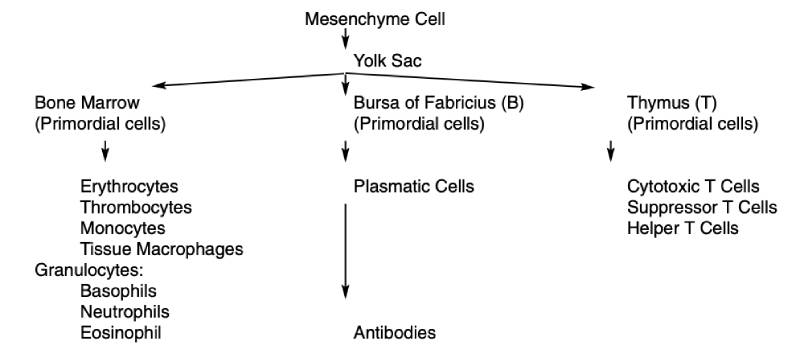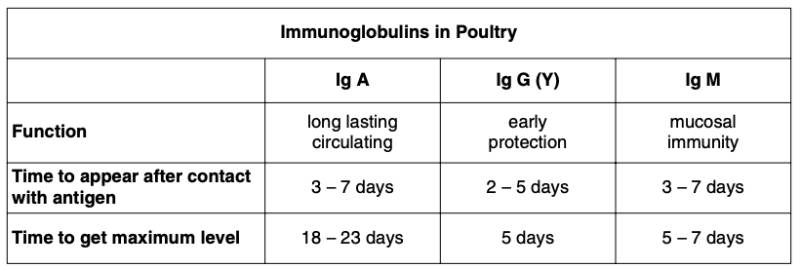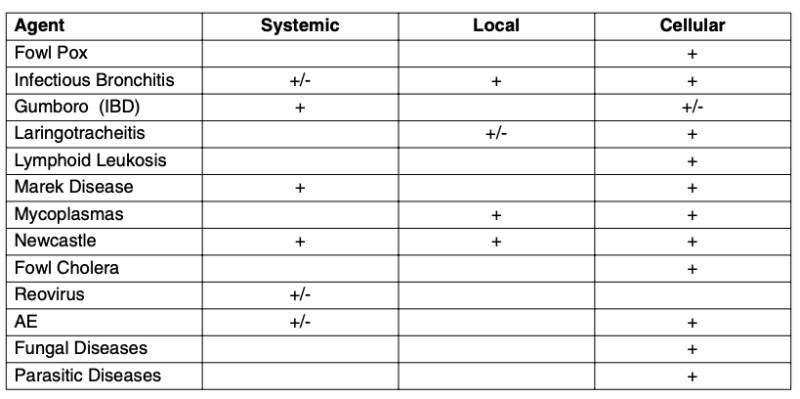Summary
The avian immune system has peculiar characteristics that make it quite different from mammals.
After the chick has hatched, the lymphoid organs are classified as primary and secondary. The first
group includes the Bursa of Fabricius (containing B lymphocytes producing antibodies) and the
Thymus (containing T cells responsible for the cellular immunity). The secondary lymphoid tissues
are organized as lymphoid cell accumulations in various locations of the chicken body (e.g. caecal
tonsils, mucosa associated lymphoid tissues). Understanding the functions of the immune system is
essential when deciding about the antigen presentation of a vaccine or the route of application.

Introduction
One of the golden rules in the poultry industry is: “only with healthy birds it is possible to get high productive efficiency and with it, economic profitability”.The first step to prevent sanitary risks is to design a correct plan for biosecurity. In addition, a correct immunization schedule has to be designed and followed for each flock, considering the health challenges expected in the region and the production conditions on a particular farm.
Birds, like all type of animals, have non- specific ways to protect themselves in order to maintain good health conditions. Intact skin and mucosa are important factors. The scan action of cilia in the respiratory tract and the low pH in the digestive tract are additional barriers to possible challenges.
In addition to these mechanisms, the normal intestinal flora acts as a kind of barrier for other potentially pathogenic bacteria competing for receptors in the gut wall and the nutritive elements they depend on. Another important point to consider is that the mucosa in the digestive and respiratory tracts as well as in the skin, secrete substances as lysozymes with an important bactericide action. All these mechanisms are part of the non-specific defense system as they act in a similar way against any challenge coming from a pathogen whatever it could be: viral, bacterial or parasite.
In a wide range of different tissues there is a type of cell called macrophage, which does not belong to the immune system but works in association with it. Macrophages have the special capacity to engulf and transform or destroy what they recognize as a foreign agent which may enter the internal media. The result of their action is subsequently introduced to immune cells.
To develop specific protection in birds against potential aggressors (bacterial, viral or parasitic), we apply different types of vaccines. To reach a good level of specific antibodies, we need to consider two different factors:
1) peculiarities of the avian immune system 2) the antigen (vaccine) we are using The following questions must be answered to optimize the vaccination program:
• which elements of the immune system are involved in the defense against an aggression?
• how do they act?
• what kind of results do we expect from the type of vaccine applied?
• what is the ultimate target for using a particular vaccination?
The Avian Immune System
Veterinarians familiar with other animal species need to understand that the avian immune system has peculiar characteristics that make it quite different from mammals.All immunity cells arise from undifferentiated mesenchyme elements from the yolk sac during the embryonic period. They migrate prior to hatch and during the first 3 days of life to other locations in the future bird as origin of different cellular strains.
After the chick has hatched, the lymphoid organs are classified as primary and secondary. In the first group we find:
1) Bursa of Fabricius, a close sac-like extension located above the cloaca. It is organized in follicles which are filled with B lymphocytes (modulated in the Bursa) where plasmatic cells have their origin. They produce the specific antibodies, which are circulating in the blood stream.
2) Thymus, a paired organ placed in the neck at both sides of the trachea formed by each five lobules. T cells multiply there and are responsible for the cellular immunity.
Table 1: Migration from the yolk sac and differentiation of cells

The avian immune system differs from that of mammals as they do not have lymphoid nodules. That is why at a regional level the so called secondary lymphoid tissues are organized as lymphoid cell accumulations. The cecal tonsils, placed in the origin of both ceca are an example of it. In other cases they are in definite structures like spleen.
Finally there are lymphoid tissue accumulations spread in the mucosa. They have a common origin as they have been colonized during the embryonic development by both type of cells, B and T. As shown in Table 2, their position is important when trying to reach the best way to get an immune response from live vaccines.
Table 2: Position of lymphoid tissues associated with mucosa and spread in different organs

Immunity and Protection in Poultry
When baby chicks hatch, they have specific immunity against different pathogenic agents called passive immunity. These antibodies came from their mothers through the yolk sac. The protection given by these antibodies is short as they disappear from the blood stream within about 10-15 days. Thereafter, each bird has to produce its own specific antibodies actively against different challenges from their environment.Active immunity is a specific reaction to an aggression from any kind of antigen. This is the goal of vaccination, i.e. to challenge the immune system with specific antigens under controlled conditions (e.g. Newcastle disease virus) to get the highest possible level of immune response. Vaccines can be prepared with live agents (modified or not) which have the capacity of multiplying in the organism or with inactivated agents (killed by physical or chemical procedures) which obviously are not able to multiply in the avian organism.
Development of the Immune Response
The immune response has different stages. It begins when the antigen has overcome non-specific natural barriers as we have mentioned previously. Then:1) the antigen is recognized as “foreign” to the organism
2) a proliferation of different cells from the immune system starts (humoral and cell-mediated)
3) the antigen is eventually eliminated
4) from that time the birds have “memory cells” which allow a quicker response to that particular antigen in case of another exposure to it
In the first stage macrophages and heterophils engulf the antigen and attract T lymphocytes and inflammatory cells to the place. Antigen is processed and presented to immune cells. Cytokines are chemical messengers secreted by T helper and other cells to attract B lymphocytes to the site. Then B cells proliferate and produce specific antibodies.
After that, memory cells lead to a quicker and higher antibody production if a new aggression from the same antigen occurs.
This complex mechanism starts each time we revaccinate. As shown in Table 3, different kinds of immunoglobulins with diverse functions are produced after contact with the antigen.
Table 3: Avian immunoglobulin characteristics

Objectives of Immunization Plans
After understanding how the avian immunity system works, it is time to focus on our objectives when organizing a vaccination schedule for a particular flock. First of all, it must be kept in mind that we are working with large populations and not with single birds; therefore our main interest is to achieve good immunity. In other words, we are not trying to get strong immunity for each individual bird, but a large number of well immunized birds in the population.Our defined targets may be different, for example:
Target 1: Prevention of economic losses associated with clinical diseases.
When we are talking about vaccination benefits, our first thought is usually to keep birds alive and to prevent a drop in production. Everybody understands the necessity to have good levels of protection against Newcastle Disease or Infectious Bronchitis, because their direct effects are easy to see and calculate.
Target 2: Prevent subclinical diseases. Financial losses can happen in an indirect way, e.g. due to Infectious Bursal Disease (Gumboro) with immunosuppression. We observe an impaired development of the flock, with reduced weight gain and increased mortality, caused by opportunistic agents. We can also see a very poor response to the vaccination against other pathogens, evaluated by routine serologic tests using ELISA. Although the vaccines are correctly applied, it is not possible to get satisfactory antibody titers.
A special case: breeder flocks seroconverting
In this case the target is to avoid vertical transmission of pathogens through the hatching egg to the offspring. Breeders may be infected during their production period with or without any clinical signs. If this happens, they will transmit the agent through fertile eggs. When the baby chicks hatch they will show clinical signs of the disease and high rates of mortality during the first and second week. Therefore, vaccination of parent stock against Chicken Anemia and Avian Encephalomyelitis is strongly recommended.In this case our goal is not only to transmit maternal antibodies to the offspring, but to expose all birds in the breeder flock to those viruses at a time when they do not show clinical symptoms and develop active immunity against them prior to onset of lay. Therefore, as they are seropositive (immune to the virus) they are not going to shed it through the hatching eggs to the day-old chicks. Target 3: Displacing very aggressive field strains Some pathogens are very difficult to control once they get into “problem farms”. This is typically the case in areas with high poultry concentration and/or poor biosecurity conditions. Examples for this could be Mycoplasma gallisepticum or Infectious Bursal Disease.
Multi-age layer farms are common in many countries, sometimes combined with the practice of molting. In addition, genetic improvement of the persistency of rate of lay and shell quality has encouraged egg producers to keep their flocks longer. Under those conditions Mycoplasmosis is a real problem. Vaccination with the mild F strain over a sufficient number of years could be a strategy to displace and eventually eliminate a virulent Mg field strain.
Another example are the so called “hot houses” with Gumboro (IBD) where an option is to use a more pathogenic strain for vaccination, accepting the risk of damaging the bursa. If this helps to displace the field strain, it is possible to go back to milder vaccines.
Target 4: Transfer of maternal antibodies to offspring.
In some cases transferring high levels of antibodies via the yolk sac from breeders is an option to protect baby chicks better during their first days of life.
It is necessary to reach really high levels of antibodies in breeders because only a part of them go through the yolk sac to baby chicks.
Sufficiently high levels could be reached using inactivated vaccines prior to the onset of lay. It is common to use one or two live vaccines during the breeder´s rearing period and then a booster vaccination a few weeks before laying starts.
Another booster with an inactivated vaccine is common in breeder flocks at about 45 weeks of age to be sure there is no decline in the antibody level. This has been a common practice in controlling Gumboro Disease, but makes it difficult to determine the best time for vaccinating the chicks for the first time. If vaccination is too early, maternal antibodies will interfere, if vaccination is too late, the field strain will have the possibility to damage the Bursa.
New technology can help to solve this problem. It is no longer necessary to know the antibody level, because the interference between vaccine and maternal antibodies has been eliminated. Using a different virus as vector (usually HVT of Marek´s disease), only a part of the genetic information of Gumboro virus is expressed.
The immune system recognizes and produces antibodies only against the segments included in the vector without interfering with maternal antibodies.
Later the technicians working in the field will decide whether it is necessary to use a live vaccine to booster the immunity. This discussion is still going on.
Against most common poultry diseases, maternal antibodies cannot protect young chicks against field virus challenge.
Different types of immunity to pathogenic agents
Finally, we must consider the different types of immunity generated by diverse pathogenic agents. Before deciding which vaccine to use and how to vaccinate, it is necessary to understand what type of immunity will be induced.Table 4: Poultry pathogens and predominant type of immunity generated
 The summary in Table 4 shows, for example, that high protection against Infectious Bronchitis in
layers is achieved with strong local immunity using a live vaccine via eye drop as a primer. In that
way the immune tissues located in the head of the birds will easily be reached. An alternative could
be spray vaccination to reach the immune tissues in the respiratory tract with the droplets.
The summary in Table 4 shows, for example, that high protection against Infectious Bronchitis in
layers is achieved with strong local immunity using a live vaccine via eye drop as a primer. In that
way the immune tissues located in the head of the birds will easily be reached. An alternative could
be spray vaccination to reach the immune tissues in the respiratory tract with the droplets.Consequently it is possible to get a good immunity, both local and cellular, especially if we repeat the vaccination at two or three different times. Layers must have a high level of circulating antibodies to secure a long lasting protection. It is necessary to booster the effect with inactivated vaccine, applied subcutaneous or intramuscular. In that way enough Ig G (Y) will be present in the blood stream. Obviously, to get the best possible protection for our birds, a combination of cellular, local and systemic immunity is needed according to the different pathogens. However, the choice of possible alternatives may be limited by the high cost of hand labor or availability.
Individual applications, like eye drop with live vaccines for respiratory diseases, have excellent results but hand labor is extremely expensive in some countries. To find the necessary balance between efficiency and cost, drinking water or spray application could be preferable. These collective ways of vaccination result in lower antibody titers, but require minimal labor cost compared to the individual options.
In other words: the type of vaccine available and route of application will be limiting the result obtained. Against Avian Influenza, only inactivated vaccines are available. That is the reason for using sentinel birds or DIVA strategy (differentiate infected from vaccinated animals) to find out what is really happening in the flock, if there is still viral activity without clinical evidence.
The avian immunity system is quite complex, so prevention plans must be designed according to the objectives we are aiming for. They must be adapted to local conditions.
The knowledge of a specialized technician in poultry diseases is always required and particular conditions in the field must be evaluated if we want the best results in each case.
References
Neumann, U. und E. Kaleta (1987): Das Immunsystem des Huhnes, Lohmann Information No 4, 1987 Reese, S., G. Dalamani and B. Kaspers (2006): The avian lung-associated immune system: a review, Vet. Res. 37 (2006) 311–324.Rose, M. Elaine (1979): The immune system in birds. Journal of the Royal Society of Medicine; Sep1979, Vol. 72 Issue 9, p701. TÎRZIU, E and M. Seres (2010): Particularities of the Avian Immune System, LUCR{RI ST»INIFICE MEDICIN{ VETERINAR{ VOL. XLIII (1), 2010 TIMISOARA
Das Immunsystem und Krankheitsprophylaxe beim Huhn
Das aviäre Immunsystem hat besondere Eigenschaften, die es deutlich von dem der Säugetiere unterscheiden. Nachdem ein Küken geschlüpft ist, werden die lymphatischen Organe als primäre und sekundäre eingestuft. Zur ersten Gruppe zählt die Bursa of Fabricius (mit Antikörper produzierenden B-Lymphozyten) und der Thymus (mit T-Zellen verantwortlich für die zelluläre Immunität). Die sekundären lymphatischen Gewebe sind in lymphoiden Zellhaufen in verschiedenen Orten des Körpers (z.B. Blinddarm Tonsillen und Schleimhaut assoziierten lymphatischem Gewebe) organisiert. Das Verständnis der Funktionen des Immunsystems ist wichtig bei der Entscheidung über die Antigenpräsentation eines Impfstoffs oder der Applikationsart.
Subscribe to our Newsletter
And find out about all the latest industry news.










